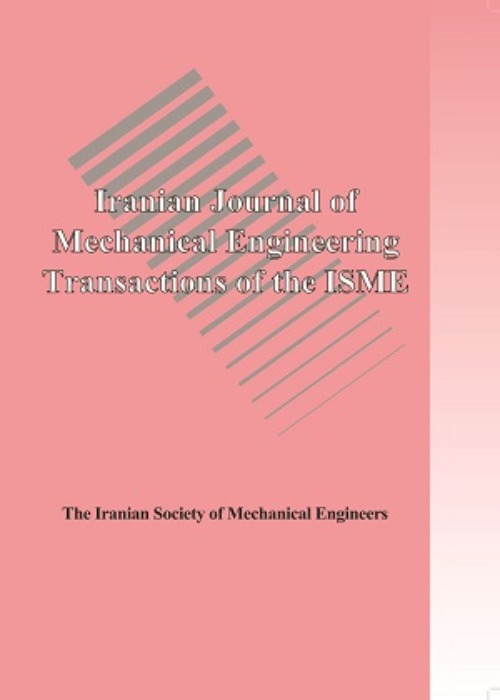فهرست مطالب
Iranian Journal of Mechanical Engineering Transactions of ISME
Volume:15 Issue: 2, Sep 2014
- تاریخ انتشار: 1395/03/20
- تعداد عناوین: 6
-
-
Instruction for the Preparation of Camera-Ready PapersPages 1-4
-
Pages 5-27Numerical Simulation of Beta Type Stirling Engine Considering Heat and Power Losses In this paper, numerical solution of beta-type Stirling engine was presented considering its non-ideal regenerator. To this end, the second-order model including heat and power losses was used. Then, a numerical code was applied for calculating geometrical and physical optimum values of the engine. To confirm the obtained results, the physical and geometrical parameters of the GPU-3 engine were used. According to the obtained results, the values of heat and power losses in the engine were considerable. Based on the results, heat and power losses in the engine led to decreased power and efficiency by 50.1% and 22.7%, respectively. According to the results from the numerical code, the amounts of porosity, frequency, and length of the regenerator were suggested as less than 0.6, 40 to 50 Hz, and 18 to 22 mm, respectively. The results showed a material with high thermal capacity and low conductivity in the optimum physical and geometrical conditions of the engine.Keywords: Stirling engine, Numerical simulation, Adiabatic model, Non, ideal regenerator, Losses
-
Pages 28-58Numerical Simulation of Beta Type Stirling Engine Considering Heat and Power Losses In this paper, numerical solution of beta-type Stirling engine was presented considering its non-ideal regenerator. To this end, the second-order model including heat and power losses was used. Then, a numerical code was applied for calculating geometrical and physical optimum values of the engine. To confirm the obtained results, the physical and geometrical parameters of the GPU-3 engine were used. According to the obtained results, the values of heat and power losses in the engine were considerable. Based on the results, heat and power losses in the engine led to decreased power and efficiency by 50.1% and 22.7%, respectively. According to the results from the numerical code, the amounts of porosity, frequency, and length of the regenerator were suggested as less than 0.6, 40 to 50 Hz, and 18 to 22 mm, respectively. The results showed a material with high thermal capacity and low conductivity in the optimum physical and geometrical conditions of the engine.Keywords: CCPP, endogenous, exogenous, avoidable, unavoidable, investment cost rates
-
Pages 59-77This paper presents the designing, simulation, fabrication and control of a gripper actuated by Shape Memory Alloy (SMA) wire. The presented gripper has the advantage of the small linear displacement of the slider connected to the SMA wire, and can convert the linear displacement into angular movement of the gripper fingers. In this study, design and simulation processes have been done by two powerful CAD and quasi-real dynamic simulation software; DS.CATIA and MSC.ADAMS respectively. Then, a gripper that actuated by SMA wire has been fabricated and the physical prototype and its mechanical and electrical properties have been presented. Finally, several experiments have been designed and performed, and the results for tip displacement of the fingers are presented and discussed. The results show that the prototyped gripper is performing to a satisfactory extent; as the fingers have been returned to their initial positions with a proper accuracy and also without any feedback control. To compensate the hysteresis phenomenon derived from SMAs wire, self-tuning fuzzy PID method was used to control the force. At first, this method has been applied on the model of the gripper by co-simulation of MATLAB and MSC.ADAMS. After that, the presented controller has been developed on the physical prototype of the gripper and its efficiency has been investigated. The experimental results demonstrate good performance of the designed controller for the tracking of the gripping force.Keywords: Gripper, shape memory alloy (SMA), fuzzy, PID, controller, fabrication
-
Pages 78-90This paper contains a theoretical formulation of multiple interface cracks in two bonded dissimilar half planes subjected to in-plane traction. The distributed dislocation technique is used to construct integral equations for a dissimilar mediums weakened by several interface cracks. These equations are of Cauchy singular type at the location of dislocation, which are solved numerically to obtain the dislocation density on the faces of the cracks. The dislocation densities are employed to evaluate the modes I and II stress intensity factors for multiple interface cracks. Numerical calculations are presented to show the interaction effects of interface cracks on the stress intensity factors.Keywords: Multiple interface cracks, Dissimilar mediums, Mixed mode fracture, Stress intensity factor
-
Pages 91-115Replacing fossil flues by renewable and sustainable energies have been the concern of scientists working in this area over the recent decades. Furthermore, greenhouses play a key role in producing various crops year-round and in bohemian climates. For this objective, the greenhouses employ heating, ventilating and air conditioning (HVAC) systems to provide the favourable conditions for the considered crop. At the moment, generally, the heating demand of greenhouses is provided by air heaters which burn gasoil as their main fuel. In this work, an innovative combined configuration of solar-geothermal heat has been proposed in order to reduce the amount of fuel consumption in the greenhouses. A comprehensive thermo economic analysis has been accomplished to demonstrate the proposed system effectiveness. The economic survey approach at this step was Net Present Value (NPV). The NPV results prove the super satisfactory performance of the proposed system with a payback period of 6.5 years.Keywords: Greenhouse, Geothermal Energy, Solar Energy, Multi, Node Storage Tank, NPV


